A local search strategy is incredibly important.
For community businesses and businesses looking to take advantage of mobile, as well as new and changing consumer behaviors, having a local SEO plan is now a necessity more than an option.
Customers across all industry types are searching for the best products and services near them – and this does not just mean retail and ecommerce.
They want local answers and services fast.
One of the significant differences between local SEO and “regular” SEO is how you target customers.
However, the differences don’t stop there.
As local consumers look for better and more relevant experiences, “near me” searches continue to rise.
About 46% of all Google searches have local intent.
Consumers with smartphones are increasingly using GPS-based apps to search for local businesses that are just blocks away from them.
Smart marketers are also enhancing their local search campaigns with hyper-local strategies such as geolocation and mapping-based tools like Google My Business listings and Google Maps.
If your business doesn’t show up when someone in your location performs a search, that’s a huge missed opportunity.
Want to stay one step ahead of your competitors?
Here’s your complete local SEO checklist to help you do just that.
Local SEO: Optimizing Your Website
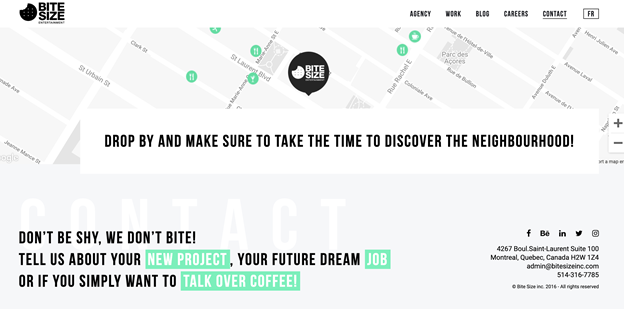
- Define your location strategy. Multi-practitioner businesses (e.g., medical, legal) have different, more complicated processes than a single location, brick-and-mortar business, or a home-based business.
- Create a contact, about, and home page on your website.
- On the contact page include the complete name, address, and phone number (NAP) for each location.
- For businesses with less than 10 locations, list all the addresses in the website’s footer.
- If you don’t want to include your business address for privacy reasons, don’t publish it. Instead, make sure to include all phone numbers used for business purposes and make them visible on the website.
- Ensure phone numbers are clickable via mobile.
- Ensure all NAP entries are consistent everywhere they are mentioned on the website.
- Add a Google Map to the Contact page so that customers can easily find you and to further improve for local SEO.
- Use Schema structured data markup to help Google more quickly identify your local business.
- Complete your Google My Business listings page and verify your website.
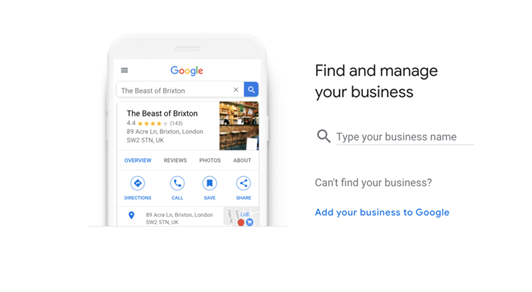
Local SEO: Content
High-quality content attracts links.
So you need a local content strategy.
Links and content are the two most important Google ranking factors.
This is also true in local SEO.
A recent Local SEO Guide study demonstrated that being proximate, ranking highly in organic results, having rich review and link profiles robust with category and geographic keywords are “still the things you need to rank in local pack results.”
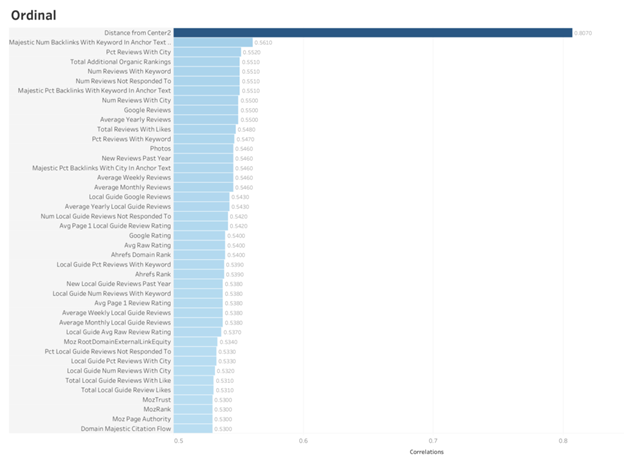
Furthermore, relevant/high-authority backlinks are still the top ranking factors to consider for local SEO.
- Create a consistent website content strategy that’s mindful of accessibility.
- Optimize title tags and meta descriptions with localized keywords (e.g., “Third Wave Coffee Shops New York” instead of “Third Wave Coffee Shops”).
- Optimize static text content and blog content with semantic variations of local keyword targets. For example, if your business is selling real estate in New York, aside from content to share information about homes, you’d also want to create content about what to do near those homes in New York.
- Include local photos and videos (optimized with relevant keywords) to enrich and complement the content.
- Publish original content.
- Clean up duplicate listings. You can do this using a free tool like Moz Local.
- While you’re at it, clean up any other duplicate content issues that might be hurting your SEO efforts.
Content for Multiple Businesses
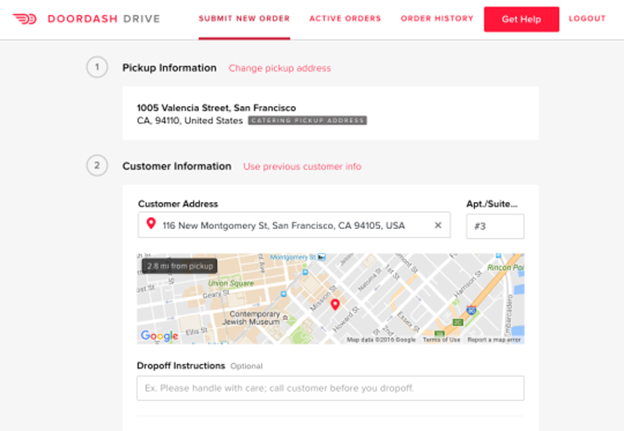
If you have multiple businesses in multiple locations, think hard about whether you need to create multiple websites.
Local SEO experts will tell you that it’s better to have one healthy website that houses all of your brands.
- Offer location-specific promotions to differentiate each location.
- Host or sponsor events in different cities to have something to write about on your website.
- Write a blog post on tips that apply to a specific demographic, season, or location.
- Create a content calendar. This allows you to plan your content and comes in handy for staying on top of seasonal content ranking opportunities.
- Use Google Trends to identify seasonal trends and edit your menus.
- Ask users to submit user-generated content (e.g., reviews, testimonials).
Local SEO: Citations
Citations are complete or partial references to your name, address, phone number, and website (NAP+W) online.
- Add manual or automatic citations. The advantage of manual citations is that you can control them, but managing them can get tedious if you decide to move or re-brand. Automatic citations, on the other hand, save you time and effort, but you ultimately have less control over your business listings.
- Use a third party for local citations and listings. These third-party providers include BrightLocal, MozLocal, Whitespark, Advice Local, and Yext.
Local SEO: Social Media & Customer Reviews
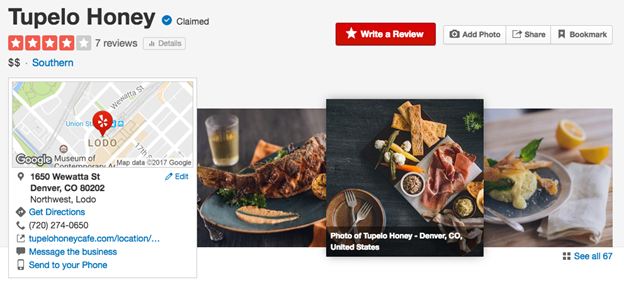
- Take advantage of customer testimonials and reviews for your products and services. Post them on your website.
- List your business on Yelp.
- List your business on Foursquare.
- List your business on Zagat (if applicable).
- List your business on Bing Places.
- If you haven’t already listed your business on Google My Business. This can have the most significant impact on your SEO because Google reviews are the first reviews people see when they do a search on Google for your business.
- Pick a business listing management tool to help you optimize your local business information across the web. There are many business listing management tools, like Acxiom My Business Listing Manager and Localhub.
- Invest in customer review management tools like BirdEye, ChatMeter, OnDemandReviews, and ReviewTrackers to notify you immediately about customer reviews that may require further action.
- Create a social media strategy.
- Identify social media sites that are popular with your customers/clients and target audience.
- Claim a profile for your business on every major social media platform. Make accounts for Facebook, LinkedIn, Twitter, Pinterest, and Instagram, for example.
- Localize all of your social networks and link them back to your site.
- Add the NAP+W to each social media listing.
- Try to get verified on these social media listings.
- Designate or hire someone to tend to all social media sites so customer queries don’t go unanswered and maintain a consistent content strategy.
- Share user-generated content on your social media sites.
- Get your Google My Business profile verified.
- Add photos to your Google My Business profile.
- Encourage customers to add reviews to your Google My Business listing, but don’t force or reward reviews! Too many reviews at any single time can cause suspicion and account suspension.
- Don’t be tempted to pay for fake reviews.
- Brush up on the rules for customer reviews.
- It’s inevitable that your business will get a negative review at some point. Be prepared to respond.
- Track and analyze your rankings, including organic keyword rank.
- Do a site audit every so often to check for any red flags.
Local SEO: The Real World

- Hire and train your employees well.
- This complete local SEO checklist is only truly useful if you consistently give your customers excellent service.
- Be present. Know your staff, customers, as well as your products and services.
- Anticipate problems before they arise. Whenever possible, have a backup plan in place.
- Hold regular meetings to celebrate, replicate the good, and learn how to avoid/reduce the bad.
- Know that the “local” in local SEO is not only confined to the internet. Maintain a mix of local advertising such as flyers, newspaper, radio, and TV advertising (depending on your budget and business).
- Do everything to make your brand the best it could be, and be the first that comes to mind when people are looking for a product or service you’re offering. Local SEO is about being top of mind.
Final Thoughts
More than a billion people use Google Maps every month, according to Google.
And more than 5 million active apps and websites are using Google Maps Platform core products every week.
Local SEO is exploding and involves many elements that are much different from general SEO best practices.
Specific local SEO strategies can help you effectively optimize your website, market your business, and reach more local customers.
Hyperlocal optimization will you stand out at that right micro-moment when customers are ready to buy.
As Google looks to provide new products and experiences for businesses, you have an incredible opportunity to show up in local searches and engage with customers in innovative new ways.
The result: more local customers.
Following this local SEO checklist can help you can get ahead in local search.
More Resources:
- Local SEO: The Definitive Guide to Improve Your Local Search Rankings
- What Is Local SEO & Why Local Search Is Important
- How to Get More from Your Google My Business Listing
Image Credits
Featured Image: Pixabay
In-Post Image: Unsplash
All screenshots taken by the author





